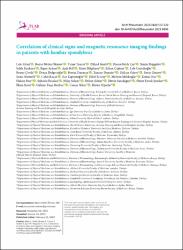Correlation of clinical signs and magnetic resonance imaging findings in patients with lumbar spondylosis

Göster/
Erişim
info:eu-repo/semantics/openAccessTarih
2023Yazar
Altan, LaleÖkmen, Burcu Metin
Tuncer, Tiraje
Sindel, Dilşad
Çay, Hasan Fatih
Hepgüler, Simin
Sarıkaya, Selda
Şahin, Nilay
Üst veri
Tüm öğe kaydını gösterÖzet
Objectives: The purpose of the study was to contribute further to this debated topic by investigating the correlation of magnetic resonance imaging
(MRI) findings with the clinical picture in lumbar spondylosis patients.
Patients and methods: This multicenter retrospective study (as part of the epidemiological project of the TLAR-OASG [Turkish League Against
Rheumatism-Osteoarthritis Study Group]) included 514 patients (101 males, 413 females; mean age: 63.6±10.8 years; range, 40 to 85 years)
who were diagnosed as lumbar spondylosis by clinical examination and direct X-ray between December 2016 and June 2018. Demographic
characteristics of patients, Visual Analog Scale for pain, presence of radiating pain, Roland-Morris disability questionnaire, straight leg raise test,
deep tendon reflexes, neurogenic intermittent claudication symptoms, any decrease of muscle strength, and abnormality of sensation were
recorded. Lumbar MRI findings of the patients were recorded as positive or negative in terms of disc herniation, intervertebral disc degeneration,
root compression, osteophytes, spinal stenosis. Statistical analysis was done to assess the correlation between the clinical symptoms, physical
examination, and MRI findings.
Results: Correlation analysis of the MRI results and the clinical findings showed a significant correlation between straight leg raise test and root
compression (p<0.001, r=0.328) and a significant correlation between neurogenic intermittent claudication and spinal stenosis (p<0.001, r=0.376).
Roland-Morris disability questionnaire had a significant correlation with all MRI findings (p<0.05, r<0.200).
Conclusion: The results of this study corroborate the notion that diligent patient history and physical examination are more valuable than MRI
findings, even though a higher incidence of abnormal MRI findings have been obtained in patients with disability and dermatomal radiating pain.

















